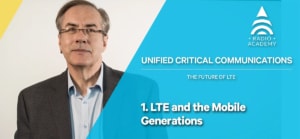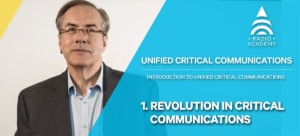One of the biggest movers and shakers in the Unified Critical Communications space is LTE. The broadband data capabilities could change the game, but will LTE ever replace LMR? Can First Responders rely on LTE to support their communications during emergencies or major events? Who is guiding the development of LTE? What’s the difference between Public and Private LTE? Continue Reading
Trying to decide which forms of wireless communication are right for your organization? In the second lesson of Introduction to Unified Critical Communications, we look at the pros and cons of LMR, WiFi, Satellite, and LTE. Continue Reading
The Tait Radio Academy is a free training resource, providing foundational education on a wide range of critical communications topics. From basic radio awareness to Industrial Control Systems, there is a range of material for people in both technical and non-technical roles.
Communications have never been more important than they are today. Businesses, public safety, utilities, and other enterprises rely on communications being available all the time. Historically, this simply meant having a reliable Radio Network. People could communicate with voice, and that was enough. But not anymore. Continue Reading
The last lesson of the Introduction to DMR Radio Academy course is Call Types and Features. This lesson consists of four topics that identify the different DMR call types and each of their features.
Trunked radio systems enable radio users to make two main types of calls on a DMR system; the first main type of call is Voice Calls.
There are many types of voice calls including individual calls, talk groups calls, and telephone and gateway calls. If you would like to learn more about these calls and how they work, watch the video below and read the accompanying Voice... Continue Reading
Great news everyone! The Tait Radio Academy has launched another new course: Introduction to Intrinsically Safe Radios.
A number of different standards worldwide help guide manufacturers, purchasers and users in the design, manufacture, selection and operation of IS radios. This course will help you to interpret these standards, based on their location in the world, and the environment under which the IS radios will be used.
The course contains 7 different videos, all taught by Stuart Colsell, a Senior Systems Engineer at Tait... Continue Reading
Do you know the function of channel rotation? What happens when a call won’t stay on a particular channel? If you are having trouble answering these questions, it might be time to brush up on your Channel Configuration knowledge.
Channel rotation is key in avoiding the situation where a channel may have problems and a call won’t stay on a channel. The lesson Channel Configuration and Numbering explains channel rotation and channel pooling, a feature that allows the same frequencies to be used on multiple sites.
If you would like to learn more... Continue Reading
The next topic in the Introduction to DMR Radio Academy course is Channel Operation and Configuration.
In the lesson Physical and Logical Channels, Noel Farrelly describes the two kinds of channels that are included in a DMR system and how they function.
By the end of the lesson, you will have in-depth knowledge of Physical and Logical Channels, be able to name and describe the two channels, how they work within the network, and what options exist for how channels can be set up. The lesson will also explain how each channel can be categorized into... Continue Reading
Do you know how many network administrators can access a DMR network at one time? Are you able to identify the tasks a network manager is able to carry out with the web user interface?
There are a number of configuration, monitoring and reporting tools that provide effective network management on the DMR radio network. These tools enable network managers to perform a number of tasks.
If you are unsure of what these tasks are specifically, the lesson DMR Network Architecture: DMR Network Management lists the tasks that can be carried out using a web browser and... Continue Reading
If a network gateway allows a single audio channel to connect to the DMR network, what is the function of a telephone gateway?
As the name would suggest, a telephone gateway is the interface that enables radio users and telephone users to communicate with each other. The DMR network utilizing a Network Gateway can support direct communications between users on DMR and telephone users.
If you weren’t sure how to answer this question, the video below and the lesson DMR Network Architecture: Telephone Gateways can give you an understanding of how telephone gateways... Continue Reading
A network gateway is a simple device, but the function of this device might need some explanation if you are not familiar with how the gateway works.
The lesson DMR Network Architecture: Network Gateways gives you an overview of how a network gateway works, function and features, and how the network gateway can be used to control the link between a conventional set of base stations and the DMR network.
By the end of the lesson, you will be able to identify the function of a network gateway, and also understand the interfacing between network gateways and Line... Continue Reading






